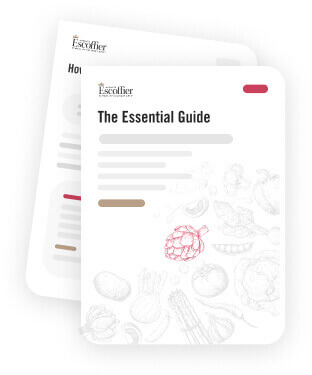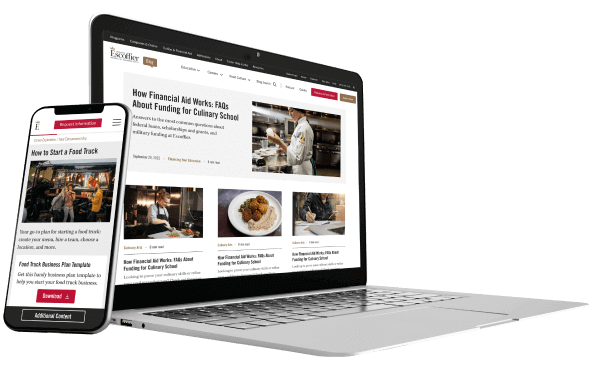Listen to This Article:
When a diner walks into your restaurant or looks your business up online, one of the first things they want to know about is the food. What kind of cuisine do you serve? How much does a meal cost? Do you have a fixed menu or a rotating selection of seasonal dishes?
A menu not only helps answer these questions but also gives diners a deeper understanding of what they can expect out of their dining experience. By spending the time to carefully create a restaurant menu, this seemingly simple piece of paper can effectively convey the restaurant’s quality standards, dining experience, and ambiance.
Know Your Restaurant’s Identity: What’s Your Service Style?
By the time you start creating a menu, you should have a good idea of the overall concept of your restaurant. Is it a Mediterranean fast-casual joint that specializes in serving lunch to hungry city workers? A plant-based restaurant that recreates classic comfort foods? An intimate fine-dining establishment with farm-to-table flair?
If you find yourself questioning what type of food you’ll be serving, start by determining the cuisine, target customers, and price points. Once you’ve figured these out, you can begin determining the exact food you’ll serve.
Before you work on the aesthetic aspects of your menu, you should determine all of the dishes you will serve. This can help you determine the size of the menu, as well as whether or not you will need separate menus for different meals or days of the week. You should also think about whether or not you’d like to create a separate delivery-friendly menu.
The Framework: Getting Your Menu Together
You’ve articulated the heart and soul of your service. Now, you need to begin putting together the fundamental aspects of your menu in a way that complements what you’ve established thus far.
Organize Your Dishes Into Sensible Categories
After you’ve written down all the dishes you’ll be serving, figure out the most logical way to organize them.
One option includes organizing dishes by category—such as soups, sandwiches, and salads. This choice is often appropriate for casual restaurants or those with a large menu.
Another option is to organize the menu by courses—appetizer, salad, main entrée, and dessert. Typically, this works best for more upscale restaurants with smaller menus.
When to Use Special Symbols in Your Menu
Rather than grouping dishes in categories like vegetarian, plant-based, or gluten-free, you can use specialized symbols to denote which dishes meet these dietary guidelines. This allows diners to easily see that a grilled chicken salad and mushroom risotto are gluten-free, for instance, or that a certain sandwich can be modified into a vegan option.
Tell a Story—or Don’t: Determine How Much Information to Share
While most everyone knows what a cheese pizza is, there are hundreds of different ways to describe this well-known dish.
A “12-inch cheese pizza” may be worth $12, but a “personal pizza crafted from freshly-milled flour, fire-roasted tomato sauce, and imported Parmigiano-Reggiano” could fetch $18 or more. However, that longer description could also dissuade casual diners from entering your restaurant.
With this in mind, think back to your ideal customers when you are writing product descriptions. If you’re hoping to draw in a crowd who cares about ingredient quality and creative flavor pairings, you may want to include multiple descriptors with each dish. However, if you are mainly serving hungry families who want a delicious and filling meal, you may want to focus on portion size and descriptive elements like juicy, gooey, fresh, or comforting.
Along with describing the dishes themselves, you’ll also need to decide what other information you’d like to share. This may be as simple as including the restaurant’s address and phone number, but it may also involve telling a story about how the restaurant came to be or sharing its mission and philosophy. Keep in mind that telling a story about a dish may make customers order it more, especially if the dish is unfamiliar to diners.
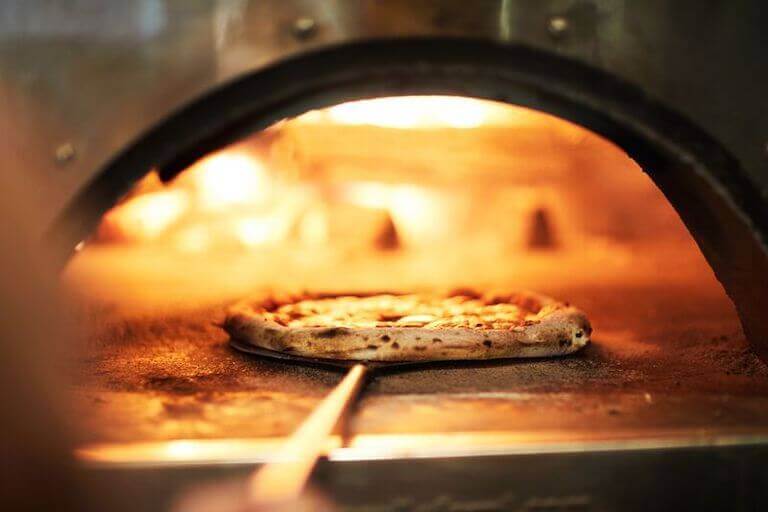
A simple cheese pizza can be described in hundreds of different ways.
Dollars and Cents: Consider How to Display Prices
Not only do the prices you set have an influence on customers, but so does the way you choose to display these prices.
Consider cents. Listing your burger for $13.95 instead of $14 subtly gives diners the impression that they’re getting a deal, but it can also make some diners feel like your food is focused on price rather than quality.
There’s also the method you use to display the price. Listing it in a large font at the end of a menu item puts the focus on the cost—which can be helpful if customers are looking for a good value. However, listing the prices in a small, faded font keeps the focus on the dish descriptions rather than their costs.
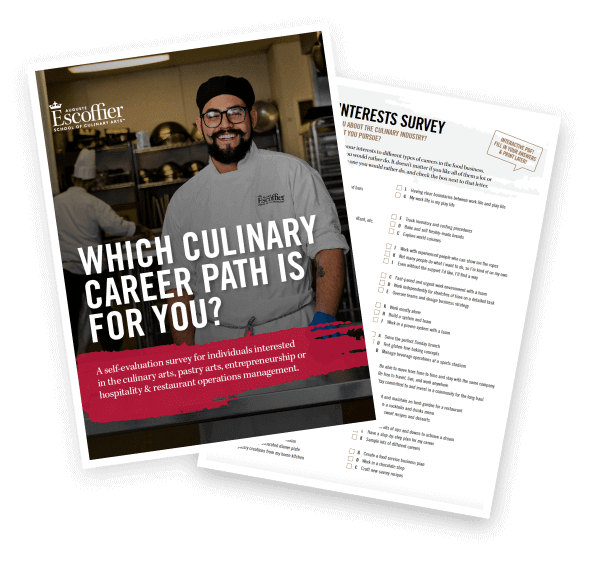
Take the Culinary Career Survey
We’ve compiled a checklist of all of the essential questions into one handy tool: career options, culinary interest surveys, educational opportunities, and more.
Create A Menu That Fits Your Theme
Once you’ve figured out the information that will be making its way onto your menu, it’s time to design it. Just as indoor decor like furniture and art is an essential part of creating the overall feel of your restaurant, so are the design elements of your menu.
Typefaces: Select an Appropriate Font
There are thousands of fonts to choose from, but that doesn’t mean you need to wade through them all. Just ensure that your font is readable and fits the tone of your space.
A clean, sans serif typeface tells your diner they’re about to enjoy simple yet modern cuisine, while an elegant serif font may indicate an upscale dining experience.
It’s common to use more than one font on a menu, but don’t go overboard. A good rule of thumb is to restrict your fonts to three: this includes both style and size. Think of it like any seasonings you might use in a recipe—using too many can overpower and spoil a dish.
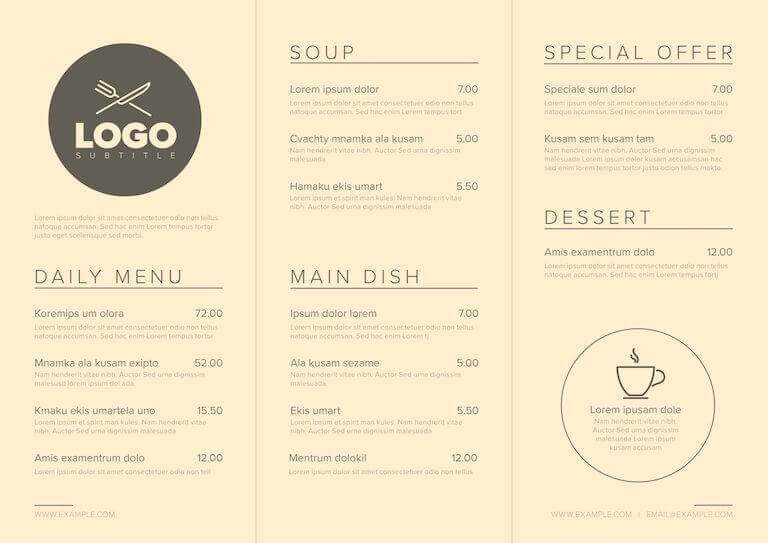
A menu font should be easy to read.
Set the Mood: Choose a Fitting Color Scheme
After you’ve chosen your fonts, the next consideration is color. The same psychology that applies to the hues you select for your signage, walls, and staff uniforms also applies to the colors you choose for the menu. Therefore, if you’ve already chosen elements like paint color, you can use these as a guide for menu color.
If you are still figuring out your color scheme, consider how colors can symbolize and even impact emotions. This doesn’t necessarily mean that using a purple hue will make people feel noble or glamorous, but it could offer an upscale feel to your establishment.
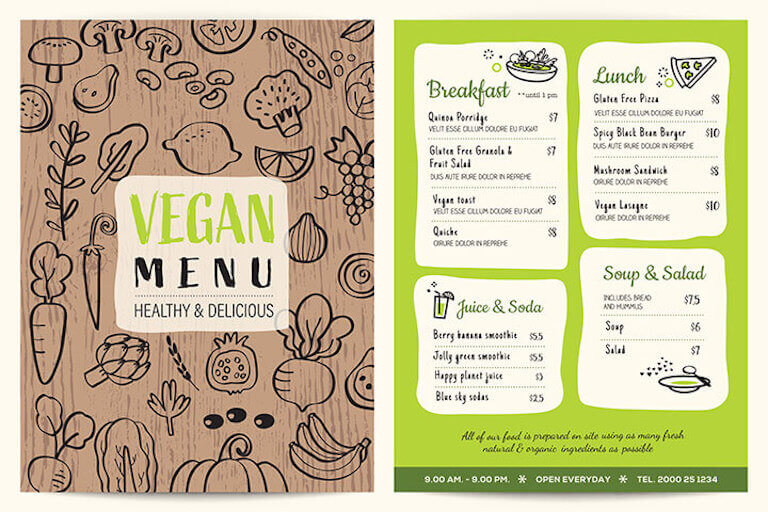
Bright colors set a fun and light mood.
1,000 Words? Determine Whether to Include Images
Next, you’ll need to decide whether or not you would like to include photos of different dishes on your menu.
Many restaurants choose not to include imagery for various reasons. Adding photos can increase the costs of producing the menus, especially if you are often changing your menu. Additionally, photos typically aren’t necessary for well-known dishes like a hamburger or spaghetti and meatballs.
If you are offering more specialized items, you may want to include at least a few photos of specific dishes. This can help diners get a feel for what they will be eating, especially if they’re unfamiliar with the ingredients used in a dish.
Lay It Out: Thoughts on Visual Organization
There are a couple of schools of thought when it comes to spacing visual elements in your menu. We’ll share them both and let you decide what makes sense for your restaurant!
The “rule of primacy and recency” means that people remember—and prioritize—the first and the last items on any list. Savvy restaurateurs put two of their highest-margin menu items at the top of each menu section, and one high-margin item at the bottom. They also limit each section to no more than seven choices. Your diners want options, but too many will overwhelm them.
Branding experts also tell restaurateurs that menus have visual “sweet spots” which draw in the reader. That’s the spot where chefs should place the most important, i.e. most profitable, menu items. Research indicated that diners beelined for the spot just inches from the top right of menus.
Yet a recent study in the Journal of Hospitality & Tourism Research suggested a different reading pattern for menus. It turned out that their test subjects sought out price information first and used that to guide their gaze through menus that organized their dishes by cost. If you’re familiar with your restaurant’s demographics, this can help you design your menu and set prices in a way that leads customers to dishes with the most favorable margins for your business.
Whatever your approach, don’t start with a blank canvas. Digital design platform Canva is a great tool to guide your menu design project, with templates to give you a headstart.

The design of your menu can guide your customers’ gazes where you want them to go.
How Does It Feel? Choosing the Right Type of Paper
Menus can be printed on thin sheets of printer paper or on pieces of thick and textured paper. Additionally, these sheets can be left in their natural states, laminated, or slipped inside plastic sleeves. The choices you make regarding paper choice can determine whether you create an affordable or high-end feel.
Alternatively, you can skip the paper entirely, and only offer your menu online. Including a QR code at your tables can allow diners to easily navigate to the online menu. This may be a good option for restaurants with frequently changing menus or a casual and young crowd, but not great for upscale establishments or those with lots of elderly diners.
Will You Keep Your Menu Current?
Creating a strong menu is a major accomplishment. But your menu shouldn’t be set in stone. Plan to revisit it from time to time to make sure you’re giving your guests what they want and contributing to your restaurant’s business goals.
Changing with the Seasons
As the seasons change, you may want to consider changing up your menu along with them. Changing your menu throughout the year can allow you to take advantage of seasonally available ingredients and offer diners the things they crave, like cool, fresh dishes in the summer months and warm, comforting ones in winter.
Rather than replacing items on your menu, you may choose to include a few rotating seasonal items that you update every few months. These regular changes can give your existing customers something to look forward to and can give you the opportunity to run seasonal promotions targeting new audiences.
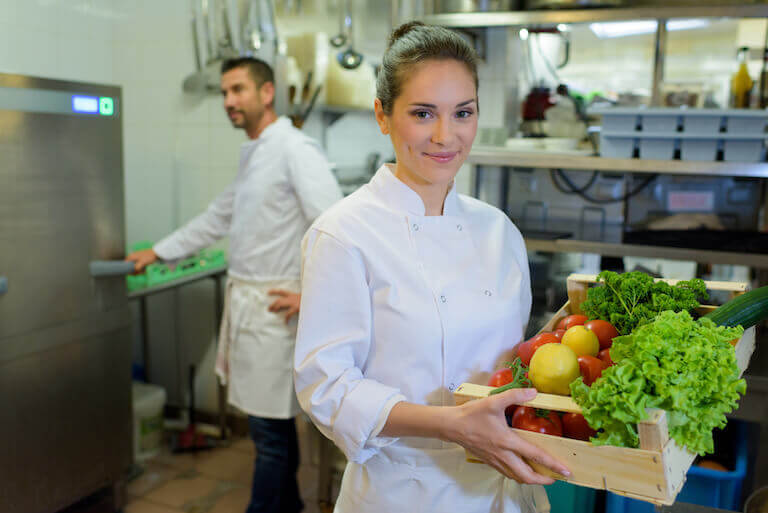
Updating your menu regularly can give you the opportunity to introduce dishes using seasonal produce.
Keeping Up with Trends
Food trends are constantly changing, and you may wish to change up your menu to reflect the evolving tastes of your customers.
Depending on your goals, this could mean a variety of things – from running a short-term promotion based on the latest social media food trend to adapting to longer-term cultural shifts, like the steady rise in plant-based cuisine.
Of course, your approach may vary depending on the concept of your restaurant. A trendy, modern date spot may have more flexibility here than a restaurant serving classic dishes with a loyal following.
But even if your restaurant tends more to the classic than the cutting-edge, you may still have opportunities to update your offering to attract new customers and give your existing clientele an exciting new reason to keep coming back. Try soliciting feedback from your diners to learn their impressions of your menu and see if there’s interest in introducing some novelty.
Refreshing Your Brand
Just as dining trends are bound to change over time, you may find yourself wanting to update your restaurant’s brand or concept as well.
Whether you’re looking to target a different customer base or take things in a new culinary direction, changing your menu offerings—along with other changes, like updating your restaurant’s ambiance—can be an opportunity to make a bold statement about your brand.
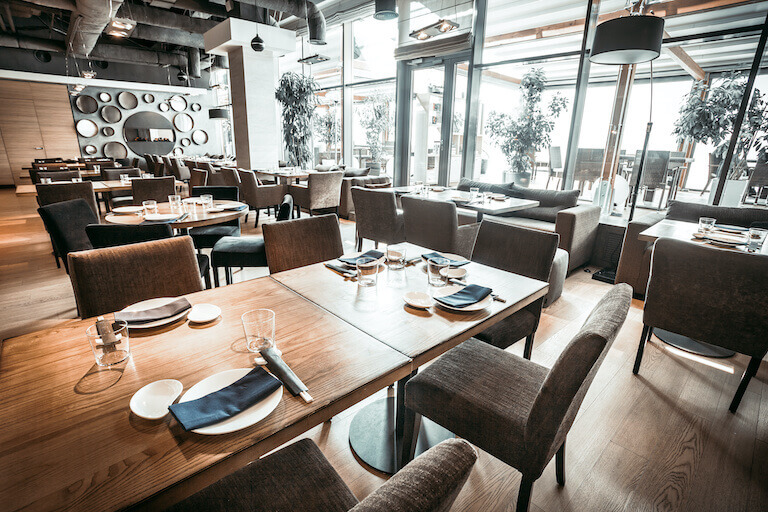
Changing your menu could be part of a broader effort to update your restaurant’s concept.
Do the Math: Protect Your Bottom Line
Above all, the items on your menu need to contribute to your restaurant’s bottom line. Whenever you’re considering making a change to your menu, do the math to make sure your decisions support the health of your business.
Keep track of your sales figures and food costs to make sure your dishes are earning as much as you would expect. It’s important to review this data regularly, as factors like inflation and shifting customer habits can affect the profitability of certain dishes over time. And if the math is no longer adding up for a particular dish, you may need to make a change, regardless of how much you’d like to keep it on your menu. That tuna carpaccio appetizer may be perfect for your restaurant’s concept – but if it’s not selling, and you’re consistently losing a portion of your fresh tuna to spoilage, then you may have to let it go.
Of course, you may be able to make other changes instead, like raising the price of a dish or running promotions. Those decisions about how to curate your menu will be easier to make when you have the numbers to back them up.
Learn More About How to Market Your Restaurant
Creating a great menu is just one component of restaurant design and marketing. You’ll also want to consider social media, positioning statements, and interior design.
Having prior knowledge of what it takes to run a successful restaurant can transform these tasks from daunting to exciting. One way to learn more about marketing, cost control, and menu design is by enrolling in a food entrepreneurship program at Escoffier.
To learn more about Escoffier’s programs, contact us today.
LIKE THIS ARTICLE? HERE ARE SOME OTHERS YOU MIGHT ENJOY:
- The Pros and Cons of Becoming an UberEats Restaurant Partner
- The 5 Best Food Truck POS Systems
- Ghost Kitchens & Ghost Restaurants: What Are They and How Do You Start One?
This article was originally published on June 1, 2022, and has since been updated.
